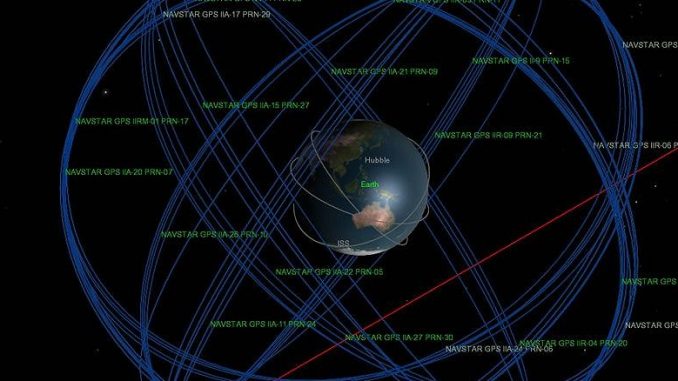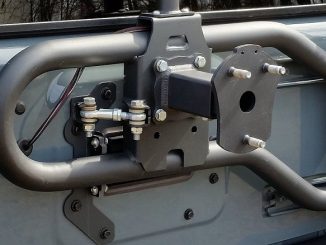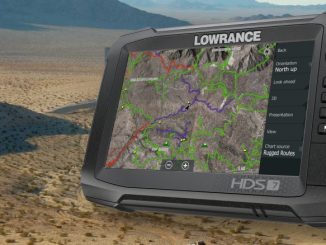
DEPARTMENT OF: Cheap Tricks & Useful Tips …
Information for educational purposes only info Courtesy of GARMIN Corporation
The global positioning system is a satellite-based navigation system consisting of a network of 24 orbiting satellites, eleven thousand nautical miles in space, in six different orbital paths. The satellites are constantly moving, making two complete orbits around the Earth in just under 24 hours. If you do the math, that’s about 1.8 miles per second. Now that’s really moving!
The GPS satellites are referred to as NAVSTAR satellites. The first GPS satellite was launched way back in February, 1978. Each satellite weighs approximately 2,000 pounds and is about 17 feet across with the solar panels extended. Transmitter power is only 50 watts, or less. Each satellite transmits on three frequencies. Civilian GPS uses the ‘L1’ frequency of 1575.42 MHz. Each satellite is expected to last approximately 10 years. Replacements are constantly being built and launched into orbit. The GPS program is currently funded with replacements through 2006.
The orbital paths of these satellites take them between roughly 60 degrees North and 60 degrees South latitudes. What this means is you can receive satellite signals anywhere in the world, at any time. As you move closer to the poles, you will still pick up the GPS satellites. They just won’t be directly overhead anymore. This may affect the satellite geometry and accuracy–but only slightly.
One of the biggest benefits over previous land-based navigation systems is GPS works in all weather conditions. No matter what your application is–when you need it the most, when you’re most likely to get lost–your GPS receiver will keep right on working, showing right where you are!
So what information does a GPS satellite transmit? The GPS signal contains a ‘pseudo-random code’, ephemeris (pronounced: ee-fem-er-is) and almanac data. The pseudo-random code identifies which satellite is transmitting–in other words, an I.D. code. We refer to satellites by their PRN (pseudo-random number), from 1 through 32, and this is the number displayed on a GPS receiver to indicate which satellite(s) we are receiving. So why there are more than 24 PRN numbers? This simplifies maintenance of the GPS network. A replacement satellite can be launched, turned on, and used before the satellite it was intended to replace actually fails! They simply use a different number (again from 1 through 32) to identify the new satellite.
Ephemeris data is constantly transmitted by each satellite and contains important information such as status of the satellite (healthy or unhealthy), current date, and time. Without this part of the message,
your GPS receiver would have no idea what the current time and date are. This part of the signal is essential to determining a position, as we’ll see in a moment.
The almanac data tells the GPS receiver where each GPS satellite should be at any time throughout the day. Each satellite transmits almanac data showing the orbital information for that satellite AND for every other satellite in the system.
By now the overall picture of how GPS works should be getting much clearer. (Clear as mud, right?) Each satellite transmits a message which essentially says, “I’m satellite #X, my position is currently Y, and this message was sent at time Z.” Of course, this is a gross oversimplification, but you get the idea. Your GPS receiver reads the message and saves the ephemeris and almanac data for continual use. This information can also be used to set (or correct) the clock within the GPS receiver.
Now, to determine your position the GPS receiver compares the time a signal was transmitted by a satellite with the time it was received by the GPS receiver. The time difference tells the GPS receiver how far away that particular satellite is. If we add distance measurements from a few more satellites, we can triangulate our position. This is exactly what a GPS receiver does. With a minimum of three or more satellites, your GPS receiver can determine a latitude/longitude position–what’s called a 2D
position fix. With four or more satellites, a GPS receiver can determine a 3D position which includes latitude, longitude, and altitude. By continuously updating your position, a GPS receiver can also accurately provide speed and direction of travel (referred to as ‘ground speed’ and ‘ground track’).
First the good news; now the bad news! What makes a GPS receiver perform below its best capability or accuracy? There are several items which add error to your GPS position, preventing you from achieving the best possible accuracy. The first of these items, and the largest source of position error, is Selective Availability (or SA). SA is an intentionally-imposed degradation in the accuracy of civilian GPS by the U.S. Department of Defense. Under SA, GPS accuracy can be degraded to a maximum of 100 meters (328 feet). Of course, they don’t typically degrade GPS accuracy to that level, but errors of 30 meters or more are not unusual.
Why does SA exist? GPS was originally designed and built for military applications. As the system evolved, many folks realized that it has numerous civilian applications as well. By presidential proclamation, Ronald Reagan declared in the early 1980s that GPS would be made available to everyone–with the exception that the best accuracy would still be reserved for the military. Since that time, satellites capable of being degraded with SA have been launched regularly. Today, all GPS
satellites are capable of and subject to SA degradation. The rationale behind SA is to deny hostile military or terrorist organizations the maximum accuracy benefits of GPS.
Another factor affecting GPS accuracy is satellite geometry. In simple terms, satellite geometry refers to where the satellites are located relative to each other (from the perspective of the GPS receiver).
If a GPS receiver is locked onto four satellites and all four of these satellites are in the sky to the north and west of the receiver, satellite geometry is rather poor. In fact, the GPS receiver may be
unable to provide a position reading! Why? Because all the distance measurements are from the same general direction. This means triangulation is poor and the common area where these distance measurements intersect is fairly large (i.e., the area where the GPS receiver thinks our position is covers a large space, so pinpoint positioning is not possible). In this scenario, even if the GPS receiver does report a position, accuracy will not be very good (maybe off as much as 300-500 feet).
With those same four satellites, if we spread them out in all directions, our position accuracy improves dramatically. Suppose these four satellites are separated equally at approximately 90 degree intervals (north, east, south, west). Now satellite geometry is very good since distance measurements are from all directions. The common area where all four distance measurements intersect is much smaller, meaning we’re much more certain where our exact position is. In this scenario, even with SA, our accuracy may be within 100 feet, or better.
Satellite geometry also becomes an issue when using a GPS receiver in a vehicle, near tall buildings, or in mountainous or canyon areas. When the GPS signals are blocked from several satellites, the relative position of the remaining satellites will determine how accurate the GPS position will be (and the number of remaining satellites will determine if a position can even be determined). As more and more of the sky is obstructed by buildings or terrain, it becomes increasingly difficult to determine a
position. A quality GPS receiver indicates not only which satellites are available for use, but where they are in the sky (azimuth and elevation) so you may determine if the signal of a given satellite is being obstructed.
Another source of error is multipath. Simply put, multipath is the result of a radio signal being reflected off an object. Multipath is what causes ‘ghost’ images on a television set. We don’t see this on a television much nowadays since it’s most likely to occur with those old style ‘rabbit ears’ antennas, not on cable. With GPS, multipath occurs when the signal bounces off a building or terrain before reaching the GPS receiver’s antenna. The signal takes longer to reach the receiver than if it travelled a direct path. This added time makes the GPS receiver think the satellite is farther away than it really is, which adds error to the overall position determination. When they occur, multipath errors typically add well under 15 feet of error to your overall position.
Are there any other sources of error? Sure. Propagation delay due to atmospheric effects can affect accuracy. So can internal clock errors. In both cases, the GPS receiver is designed to compensate for these effects and will do so quite efficiently. But, very small errors due to these items can still occur. If you’re wondering, propagation delay is the ‘slowing down’ of the GPS signal as it passes through Earth’s ionosphere and troposphere. In space, radio signals travel at the speed of light, but they are significantly slower once they enter our atmosphere.
How accurate is GPS, really? A typical civilian GPS receiver provides 60 to 225 feet accuracy, depending on current status of selective availability, number of satellites available, and the geometry of those satellites. More sophisticated and expensive GPS receivers, costing several thousand dollars or more, can provide accuracies within a centimeter by using more than one GPS frequency. However, a typical civilian GPS receiver’s accuracy can be improved to fifteen feet or better (in some cases under three feet!) through a process known as Differential GPS (DGPS). DGPS employs a second receiver to compute corrections to the GPS satellite measurements. How are these corrections provided to your GPS receiver? There are a number of free and subscription services available to provide DGPS corrections. The U.S. Coast Guard and U.S. Army Corps of Engineers (and many foreign government departments as well) transmit DGPS corrections through marine beacon stations. These beacons operate in the 283.5 – 325.0 kHz frequency range and are free of charge. Your only cost to use this service is the purchase of a DGPS Beacon Receiver. This receiver is then coupled to your GPS receiver via a three-wire connection, which relays the corrections in a standard serial data format called ‘RTCM SC-104.’
Subscription DGPS services are available on FM radio station frequencies or via satellite. Of course, in either case you need a separate receiver to pick up these transmissions and then send them to your GPS receiver. In some cases, the prices vary according to the level of accuracy desired.
So what’s the best GPS receiver for me? Now, that’s the ultimate question, isn’t it? And certainly the hardest one to answer. A number of issues come into play here:
1. What is the intended application? The most important issue is finding a GPS suitable for your
application. If your particular need is for an panel-mounted GPS in your airplane, a handheld designed for the recreational boater is obviously of little value! You can quickly narrow your choices down by identifying which models are available for your application.
2. In some cases, you may still have alot of choices from which to choose. For example, if your intended use is hiking or hunting, a GPS for outdoor recreation is suitable–but so is a handheld GPS designed for boating or flying. In this case you may have to examine specific features more closely. Unless you plan on flying too, all the extra information of airports contained in the aviation handheld GPS probably isn’t worth the extra price. A marine GPS which uses cartridges to show navigation markers and depth contours won’t help out much on the trail either (unless you also want to use the GPS on your yacht!).
3. What is the price range? Once you’ve narrowed the field, you’ll most likely still have several models over a range of prices from which to choose. Examine each model closely. What do the higher-priced models have that the lower-priced models do not? Do you need the extra features or accessories that come with the higher-priced model or is the lower-priced model sufficient to do the job?
4. Which model do you like the best? Choosing the right GPS receiver for you is two parts rational planning and one part simple preference. If rational planning still leaves you with two or three models to choose from. Sometimes the differences in operation are dramatic. You may find one real easy to use and understand, while another seems much more complicated and difficult to use. Choose the GPS receiver that you LIKE best. You’re more likely to still be happy with the decision you made after one month or one year.



